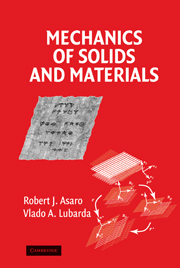Book contents
- Frontmatter
- Contents
- Preface
- PART 1 MATHEMATICAL PRELIMINARIES
- PART 2 CONTINUUM MECHANICS
- PART 3 LINEAR ELASTICITY
- PART 4 MICROMECHANICS
- PART 5 THIN FILMS AND INTERFACES
- PART 6 PLASTICITY AND VISCOPLASTICITY
- 26 Phenomenological Plasticity
- 27 Micromechanics of Crystallographic Slip
- 28 Crystal Plasticity
- 29 The Nature of Crystalline Deformation: Localized Plastic Deformation
- 30 Polycrystal Plasticity
- 31 Laminate Plasticity
- PART 7 BIOMECHANICS
- PART 8 SOLVED PROBLEMS
- Bibliography
- Index
30 - Polycrystal Plasticity
Published online by Cambridge University Press: 06 July 2010
- Frontmatter
- Contents
- Preface
- PART 1 MATHEMATICAL PRELIMINARIES
- PART 2 CONTINUUM MECHANICS
- PART 3 LINEAR ELASTICITY
- PART 4 MICROMECHANICS
- PART 5 THIN FILMS AND INTERFACES
- PART 6 PLASTICITY AND VISCOPLASTICITY
- 26 Phenomenological Plasticity
- 27 Micromechanics of Crystallographic Slip
- 28 Crystal Plasticity
- 29 The Nature of Crystalline Deformation: Localized Plastic Deformation
- 30 Polycrystal Plasticity
- 31 Laminate Plasticity
- PART 7 BIOMECHANICS
- PART 8 SOLVED PROBLEMS
- Bibliography
- Index
Summary
In this chapter we explore the transition from the plastic response of single crystals to that of polycrystalline aggregates. The treatment given here is not meant to be exhaustive but rather to reveal some of the more fundamental issues involved. Suggested reading provides the link to the rather large volume of research conducted during the past two decades on the subject. The basic issues to be explored include the link between the micromechanical mechanisms of deformation on the scale of individual grains and macroscopic elastic-plastic response. One particular aggregate model is developed in detail and used to examine several physical phenomena. Among these are the development of crystallographic texture and anisotropic macroscopic response. We use the model to perform “numerical experiments” to define yield surfaces as they might be measured experimentally. We note how such surfaces naturally develop structure that is described as corners and explore the significance of this vis-à-vis the plastic strain response to sudden changes in strain path. We study this path dependent behavior further by appealing to simple rate-independent flow and deformation theories thus completing the link between microscopic and macroscopic behavior. The development of anisotropic plastic behavior is shown to occur after only modest deformation of initially isotropic aggregates.
Perspectives on Polycrystalline Modeling and Texture Development
Polycrystals are continuous 3D collections of grains (crystallites), which, as assumed herein, can deform by cyrstallographic slip. As such, the actual solution to a problem of a deforming polycrystal is that of a highly complex elastic-plastic boundary value problem for a large collection of anisotropic, continuous, and fully contiguous crystals.
- Type
- Chapter
- Information
- Mechanics of Solids and Materials , pp. 586 - 600Publisher: Cambridge University PressPrint publication year: 2006



